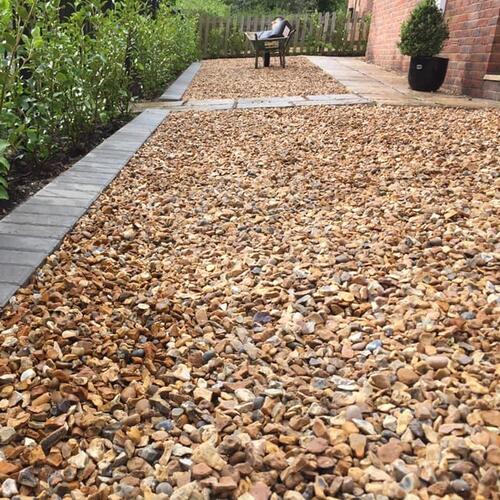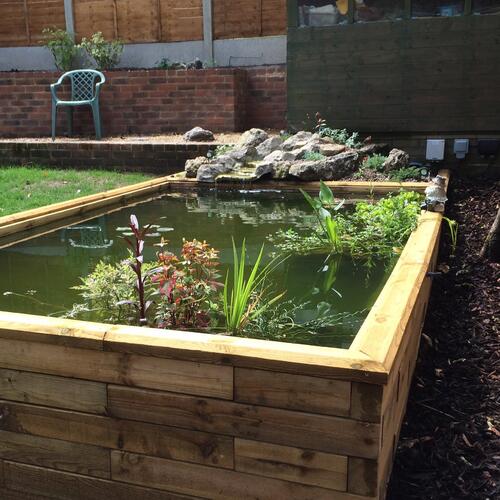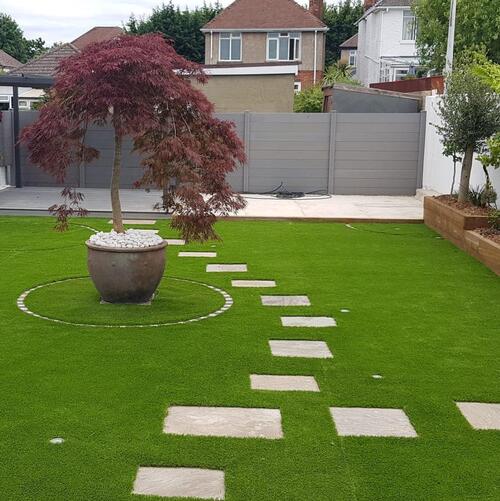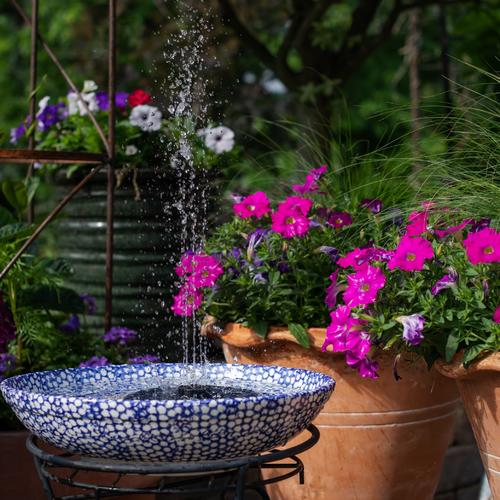Affordable Garden Design Ideas
We know that creating your dream garden is not an easy task, there are many decisions involved and lots of problems to solve, it can also be a costly endeavour. Especially as we are nearing the holiday season, we understand that creating a cost-efficient garden is the ideal solution for many households because not only will you end up with a rejuvenated garden, but you will also be ensuring that you remain within budget. To help you on your way, we have come up with 5 affordable garden design ideas that will hopefully give you some inspiration.

Gravel Pathway
Gravel is generally less expensive than many other paving materials like concrete, brick, or natural stone. The initial cost of purchasing and installing gravel is often lower, making it a budget-friendly option.
Gravel pathways are relatively easy to install, especially compared to more complex paving materials. This can result in lower labour costs if you're hiring someone to install the pathway, or it can save you time and effort if you're doing it yourself.
Gravel is a versatile material that can complement various garden styles and themes. It comes in different sizes and colours, allowing you to choose the type of gravel that best suits your aesthetic preferences. This flexibility makes it easy to create a unique and visually appealing garden pathway on a budget.
Gravel allows for excellent water drainage. This is beneficial for preventing water pooling and reducing the risk of erosion, especially in areas with heavy rainfall. Proper drainage helps maintain the integrity of the pathway and the surrounding garden.
Gravel pathways are relatively low maintenance. They don't require sealing, and weeds are generally easier to control compared to solid surfaces. Regular raking and occasional replenishing of gravel can help keep the pathway in good condition without significant ongoing costs.
If you enjoy DIY projects, installing a gravel pathway can be a satisfying and cost-effective endeavour. With basic tools and some guidance, you can create a functional and attractive pathway without the need for specialized skills or expensive equipment.
Gravel pathways can be easily modified or extended as your garden evolves. If you decide to change the layout or expand your garden, adjusting or adding to a gravel pathway is a straightforward process.

DIY Pond
Compared to pre-made, professionally installed ponds, the materials required for a DIY pond are often more budget-friendly. You can choose from a variety of materials, such as flexible pond liners, pre-formed plastic ponds, or even repurposed materials, depending on your budget.
DIY ponds allow you to be creative with the design, shape, and size of your water feature. You can adapt the project to fit your available space and budget, avoiding the need for expensive customization that often comes with professionally designed ponds.
You can often find materials for your pond project at a lower cost by repurposing items or using reclaimed materials. For example, you might use an old bathtub or stock tank as the basis for your pond, reducing the need to purchase a dedicated pond basin.
Doing the work, yourself eliminates labour costs associated with hiring professionals for pond installation. While building a pond requires effort, it can be a satisfying and cost-effective DIY project, especially if you enjoy hands-on work.
Take advantage of local resources for sourcing materials. Local landscaping or garden centres may offer discounts on pond supplies, and you may find affordable plants and aquatic life in your area.
A smaller DIY pond requires less energy for maintenance, such as pumping and filtration. This can result in long-term cost savings on electricity bills compared to larger, more complex pond systems.
Designing a simple pond with minimal features can reduce long-term maintenance costs. Consider low-maintenance plants and a balanced ecosystem that requires fewer additives and interventions to keep the pond healthy.

Artificial Grass
While the initial investment in artificial grass may be higher than natural grass seed or sod, it often proves to be more cost-effective in the long run. Natural grass requires ongoing expenses for water, fertilizers, pesticides, and regular maintenance, while artificial grass has minimal ongoing costs.
One of the most significant cost savings with artificial grass is the reduction in water usage. Natural grass lawns often require regular watering to stay lush and green, especially in arid or drought-prone regions. Artificial grass doesn't need watering, leading to significant water bill savings over time.
Artificial grass is virtually maintenance-free compared to natural grass. You don't need to mow, fertilize, or apply pesticides. This not only saves you time and effort but also eliminates the need to purchase lawn care equipment or hire lawn maintenance services.
Artificial grass is highly durable and can withstand heavy foot traffic, pet activity, and adverse weather conditions without showing signs of wear and tear. This durability translates to long-term cost savings as you won't need to replace or reseed damaged areas as you might with natural grass.
Maintaining a natural lawn often involves the use of fertilizers, herbicides, and pesticides. With artificial grass, there's no need for these chemicals, leading to cost savings and a reduction in potential environmental impacts.
Artificial grass maintains its vibrant green appearance throughout the year, regardless of weather conditions. This means you won't need to invest in lawn treatments or overseeding to keep your garden looking attractive during different seasons.
For individuals with grass allergies, artificial grass can provide relief by minimizing exposure to pollen. This can reduce healthcare costs associated with allergy management.
Depending on the size of your garden, artificial grass can be a DIY-friendly project. While professional installation may yield the best results, installing artificial grass yourself can save on labour costs.
High-quality artificial grass can have a lifespan of 15 years or more with proper care. This longevity ensures that your initial investment provides ongoing value over an extended period.

DIY Water Feature
DIY water features often allow for flexibility in choosing materials, making it possible to use more budget-friendly options. For example, you can repurpose containers, use inexpensive pond liners, or select affordable decorative stones.
Building your own water feature gives you the freedom to get creative and design a feature that suits your taste and fits within your budget. You can personalize the size, shape, and style of the water feature without the added costs of customization from professionals.
Look for opportunities to repurpose materials for your water feature. Old containers, buckets, or tubs can be transformed into unique water features with a bit of creativity. Repurposing items can save money compared to buying new components.
Simple DIY water features, such as small ponds or bubbling fountains, typically require less energy for pumps and filtration compared to larger, more complex systems. This can result in long-term cost savings on electricity bills.
Choose low-maintenance features and plants for your water feature to reduce ongoing costs. Simple designs with minimal moving parts are generally easier and less expensive to maintain.
Budget-Friendly Bark Nuggets
Bark nuggets are often more affordable than other landscaping materials such as decorative stones or mulches. The cost can vary based on the type of bark, its source, and the size of the nuggets, but in general, bark nuggets provide good value for their price.
Bark nuggets can be used as a mulch, which has several advantages. Mulching helps retain soil moisture, suppress weed growth, and regulate soil temperature. This can reduce the need for frequent watering and minimize the use of herbicides.
Bark nuggets create a protective layer over the soil, inhibiting weed growth. This reduces the time and effort required for weeding, as well as the need for chemical weed control methods, contributing to long-term cost savings.
Over time, as bark nuggets break down, they can contribute organic matter to the soil, enhancing its fertility. This natural decomposition process can improve soil structure and nutrient content, potentially reducing the need for additional soil amendments.
Bark nuggets can help prevent soil erosion by providing a protective covering. This is particularly beneficial on slopes or in areas where heavy rainfall or irrigation may lead to soil displacement.
Bark nuggets come in various sizes and colours, allowing you to choose a style that complements the overall design of your garden. Their natural appearance can add a rustic or woodland charm to the landscape.
Applying bark nuggets is a relatively simple and DIY-friendly task. This can save you money on labour costs, as you can easily spread the nuggets around garden beds, pathways, or other areas without requiring specialized skills or equipment.
Once installed, bark nuggets generally require minimal maintenance. Periodic replenishing may be necessary over time as they break down, but this is a simple and cost-effective task.
Bark nuggets can provide insulation to the soil, helping to regulate temperature extremes. This can be particularly beneficial in regions with hot summers or cold winters.

